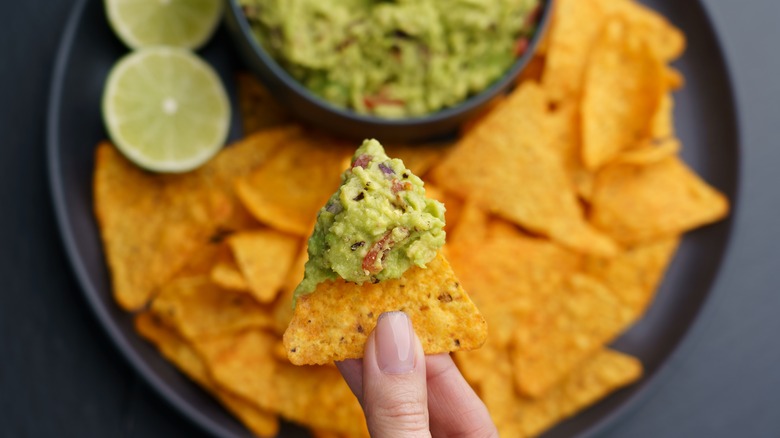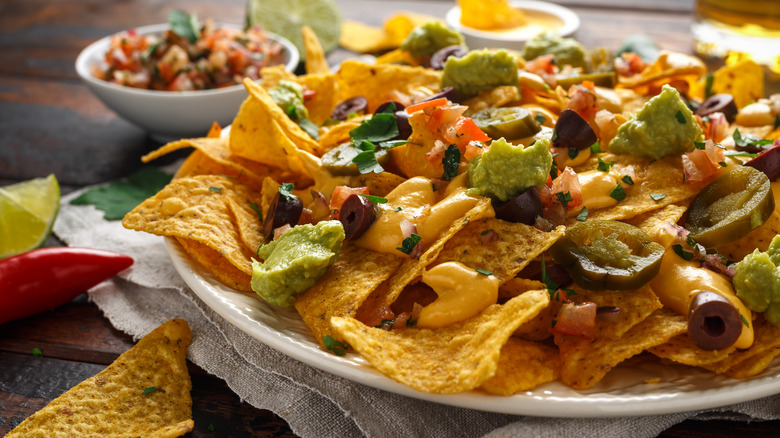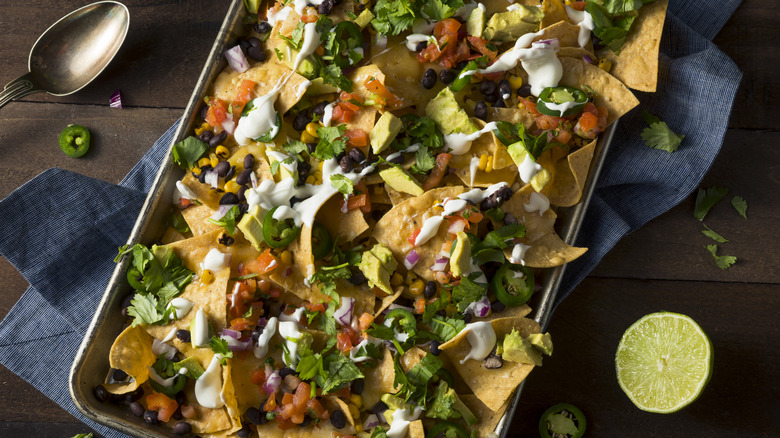The Key To Perfectly Coated Nachos Is All In The Layering
Whether you're "Beavis and Butthead" in the 1990s or you're visiting your local Taco Bell for lunch, you're more likely than not getting some nachos. Usually made up of tortilla chips and melted cheese, this snack has been the darling of Mexican restaurants, convenience store snack counters, and just about every college kid in America.
Nachos, as we know them today, were invented by one Ignacio "Nacho" Anyas, a maître d at Club Victoria in Piedras Negras, Mexico during the 1940s. A group of tourists came in one day and ordered some food, unaware that the head chef was out for the day. Anyas, wanting to keep the tourists' business, quickly prepared a sort of appetizer using scraps he found around the kitchen — tortilla chips, some cheese, and some sliced jalapenos. It was this on-the-fly appetizer that would soon become the famous nacho snack, with cheese and jalapenos still remaining a popular item. Today, an average of 79% of Americans enjoy nachos, whether they be prepared by Guy Fieri or made at home using Doritos, shredded cheese, and a microwave.
But for as easy as nachos are to make, they can be pretty "uneven." You're either getting a whole bunch of chips that are absolutely smothered in toppings, or you're getting a handful of warm, plain tortilla chips. How can you make nachos that aren't just a pile of toppings dumped randomly on a bowl of chips?
Layer your nachos instead of piling them together
Here's a question for you: in what way are nachos like lasagna? Is it because they both involve cheese in some way? Is it because they're both really good? While these answers aren't wrong, the real answer to this question is that both nachos and lasagna include layers — that is, if you prepare your nachos correctly.
Nachos should never just be dumped on a plate and tossed in a microwave until the mess looks done. Instead, nachos should follow a series of "layers," or an alternating pattern of chips and toppings in an organized structure, much like how lasagna is pasta, sauce, and meat. Although many nachos will make us of refried beans and ground beef, you're free to use whatever kind of meats and fillings you want.
But how to build this "perfect nacho structure?" A useful and simple method for this is simply layering your chips on a sheet pan and covering with your toppings, giving you a flat but evenly-spread layer, similar in construction to spreading sauce and cheese over a pizza. You can also experiment by adding your nacho ingredients into a deep casserole dish, and layering your ingredients on top of each other like some kind of nacho casserole. The key is to find a balance between finding a good structural balance and ensuring all the flavors play a role in the nachos.
Don't be afraid to experiment with nachos
Your standard nacho recipe is pretty simple: chips, cheese, meat, and maybe some jalapenos here and there if you're feeling particularly crazy. While these are the foundations of any good nacho recipe, there are many other toppings and fillings that can turn any nacho dish into something that tastes like it came straight out of a restaurant.
You could, for example, experiment with different types of meat you're using. You can use anything from standard ground beef if you want to keep it traditional, or you could add your favorite choice of pulled meat like pulled chicken or pulled pork. You could even go so far as to follow in the footsteps of Las Vegas-based restaurant "Nacho Daddy" and add meats like boneless wings, lobster, and filet mignon.
Aside from the meat, you could also experiment with adding other snack foods (as if adding chips and cheese together wasn't enough). One particular example includes Food Network's recipe for nachos. Not only are these nachos loaded with chili, but they also utilize waffle fries instead of chips. Tostitos also offers up a suggestion of combining southern fried chicken and "cheddar gravy" with nachos in a recipe supposedly based on the Atlanta Falcons.
So long as you have some chips and some cheese, nachos can be your culinary canvas.


